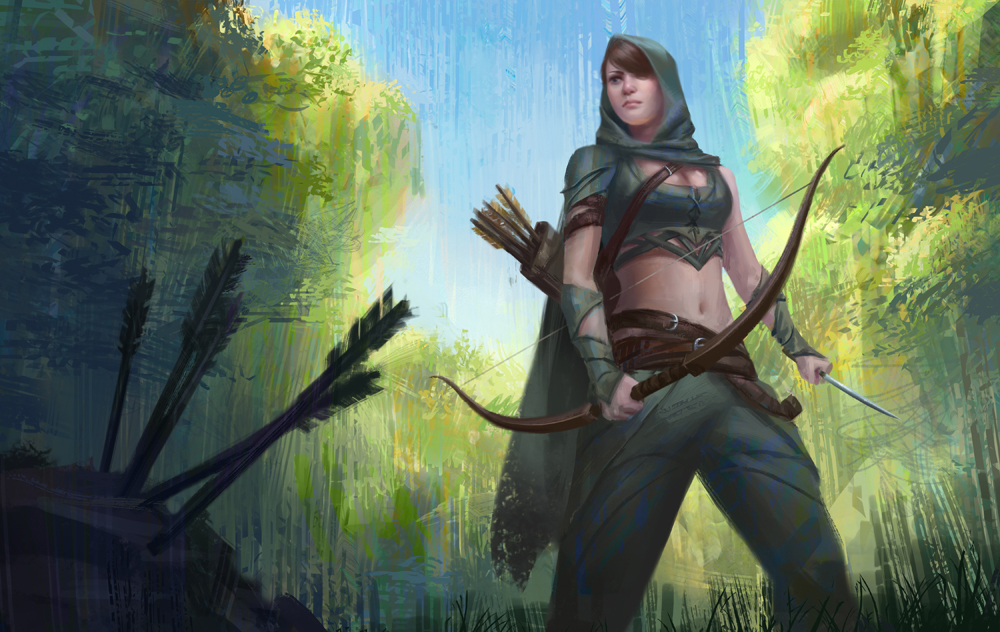Palesian Cloak
The most identifiable item of the Scouts of Palesia are their Palesian cloaks. Indeed, within the Aeriscan League the Scouts are often refered to as "Greencloaks," due to their association with the garment. In addition to keeping a Scout warm, the cloak also serves as protection from the rain, hunter's camouflage, a bedroll, a makeshift satchel, and finally, a burial shroud.
Typically worn as a traveller's cloak, a Scout may also don the garment as a waistband, loincloth, skirt/sarong, or turban as circumstances require. When worn on the shoulders, the cloak is held closed by a simple sliver brooch.
Mechanics & Inner Workings
The secret to the superior water-repellant and tear-resistant properties of a Palesian cloak is the naturally high amount of lanolin present in the shorn wool of the Kharadim sheep. In order to ensure a constant supply of this special wool, some Scouts choose to live as solitary itinerant shepherds who roam across the wilderness of Aerisca Borealis with their flocks of Kharadim sheep. Known by the Naric term "Ra'yim," they occupy an honored status within the Scouts.
Manufacturing process
When children raised in a Scout band reach adolescence, (typically at 14 or 15 years of age) they are tasked with the creation of a cloak as a demonstration of their maturity and mastery of woodcraft. In order to acquire the materials necessary for the construction of a cloak, a Scout initiate must venture forth into the Aeriscan wilderness to find one of the nomadic Ra'yim who raise the sheep that produce the special Kharadim wool used for the cloak. As the shepherds intentionally live far away from civilized areas, this is considered a test of the Scout's ability in tracking and survival. Through an understanding of the secret system of blazes used by the Scouts, the young initiate follows wilderness trails until a shepherd is found. The Scout is then given a skein of wool by the shepherd as a reward for successfully tracking him or her down.
After receiving the skein of wool, the Scout must then spin it into yarn using the spindle and distaff given to him or her before setting forth on the quest. The process of hand spinning is considered a test of the initiate's dexterity and patience. Afterwards, the yarn must be dyed using particular varieties of woad (for blue) and weld (for yellow) until it is the correct shade of green to be considered a Palesian cloak. Locating and harvesting the plants used for the dye in the scrublands of Aerisca Borealis tests of the Scout's knowledge of herbalism. The dyed yarn is then woven into fabric using a portable back strap loom carried by the initiate for this purpose. Like the spinning, the weaving is a demonstration of a Scout's manual skill and attention to detail, as the fabric used in a Palesian cloak must have a high thread count in order for it to successfully display the water and tear resistant characteristics so valued by the Scouts. Finally, the Scout initiate then tailors the fabric into a cloak using a pattern given to him or her by his or her parents. Upon finishing the cloak, the young Scout initiate returns to his or her band to be judged on the craftsmanship displayed in the construction of the cloak. If the cloak is deemed worthy by the elders of the band, the initiate is considered a fully adult Scout with all the rights and responsibilities entailed.
Significance
A Palesian cloak is an outward sign of membership in the Scouts and serves as both advertisement for the Scout's services and warning to any who would seek to cause harm. So important is the cloak to the Scouts of Palesia, it is one of the three items Scouts vow to have on their person at all times. Only the most foolhardy would dare don a Palesian cloak and not be a Scout as they would attract negative attention from both the Scouts (who would assume the wearer killed its rightful owner) and their enemies (who would assume the wearer is a Scout).
Each Scout constructs his or her own cloak from materials he or she collected and manufactured as a rite of passage. Whereas spinning yarn and weaving fabric is seen as women's work to most Aeriscans, both men and women raised within the Scouts of Palesia learn these arts from a young age, as it is seen as part of the self-sufficency necessary for a Scout's life.
O Bira! Bless this cloak of green,
So by my prey, I am not seen!
- Kharadim wool
- Palesian Green dye
- Spindle and distaff
- Back strap loom
- Shears, needle and thread


